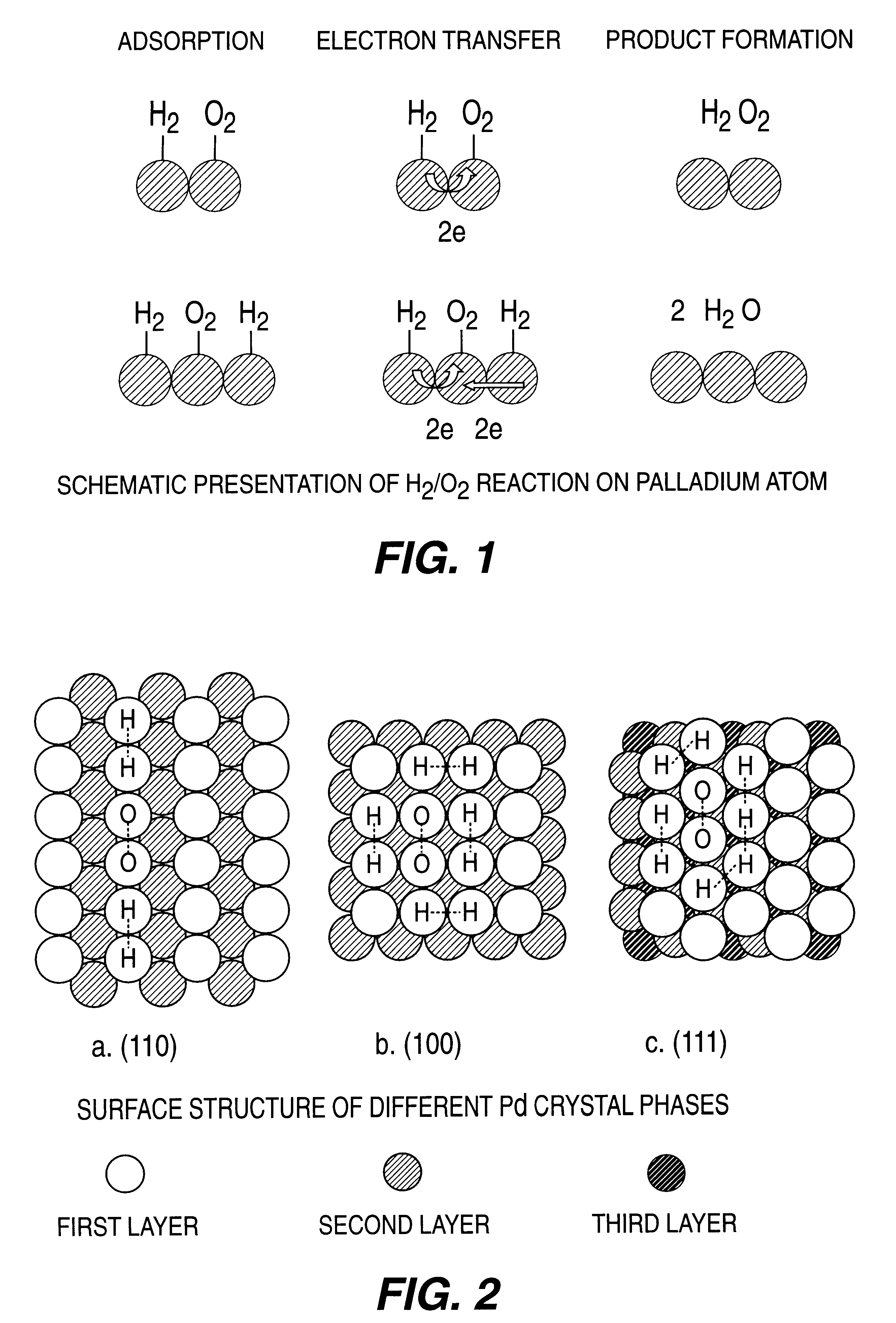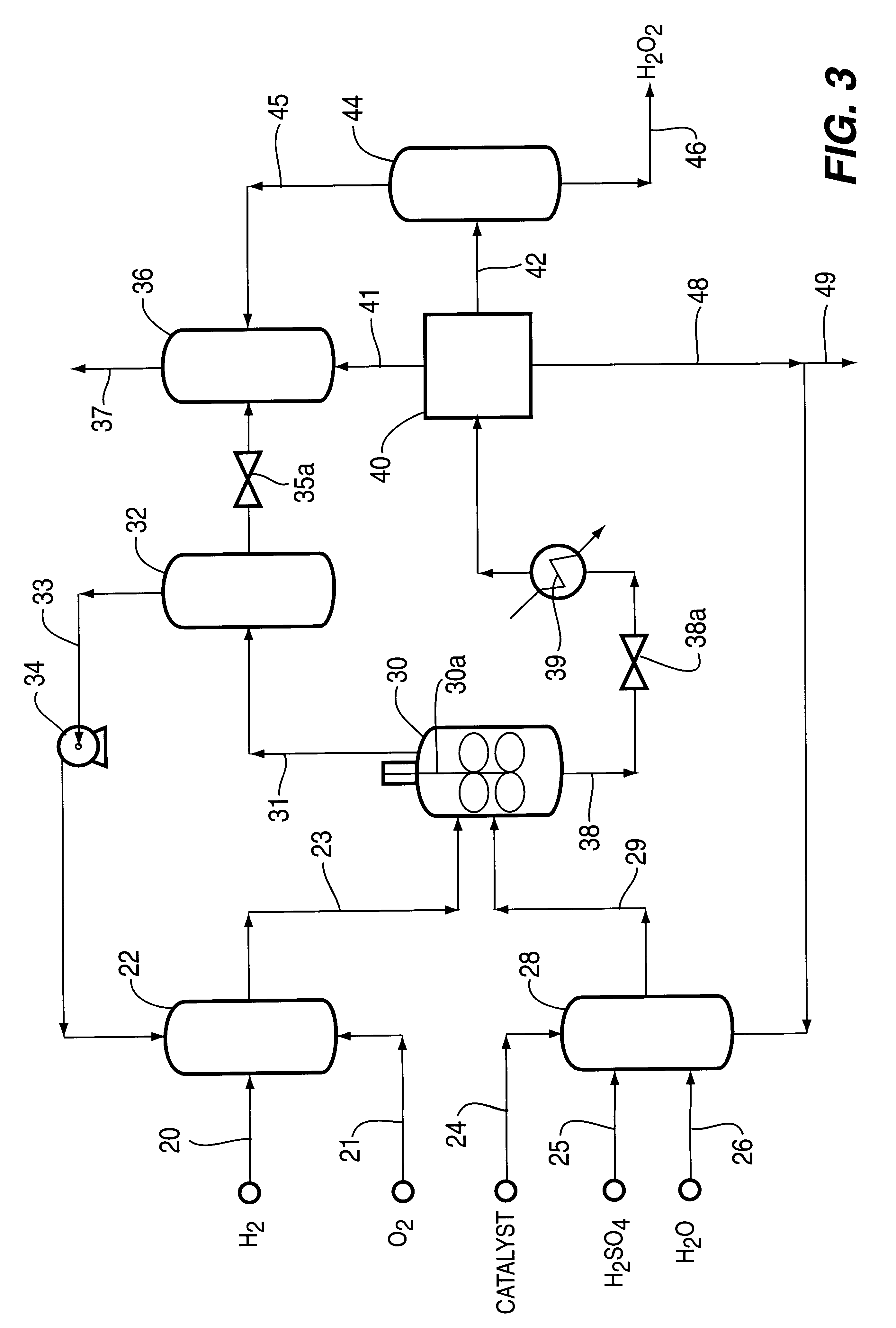Catalyst and process for direct catalytic production of hydrogen peroxide, (H2O2)
a technology of hydrogen peroxide and catalyst, which is applied in the direction of catalyst activation/preparation, metal/metal-oxide/metal-hydroxide catalyst, physical/chemical process catalyst, etc., can solve the problem of low yield and some safety problems, and the proposed direct production technology has not yet been commercialized, so as to improve the catalyst and its activity and product selectivity, and achieve high catalytic activity.
- Summary
- Abstract
- Description
- Claims
- Application Information
AI Technical Summary
Benefits of technology
Problems solved by technology
Method used
Image
Examples
example no.1
EXAMPLE No. 1
Several experimental screening runs were made with catalyst samples made utilizing various support materials to determine desired characteristics of effective support materials for an improved supported palladium catalyst useful for the direct production of hydrogen preoxide (H.sub.2 O.sub.2) from hydrogen and oxygen feedstreams. The screening runs for the catalyst samples made in a stirred glass lined one-liter capacity autocalve unit, using as feed gases 1.9% hydrogen in air at reaction conditions of 35.degree. C. temperature and 1000 psig pressure, with catalyst concentration of 10 grams catalyst per liter of liquid at feedgas rate of 1 liter / minute for 3 hours duration. The results are shown in Table 1 below.
From these results, it is seen that the support materials having surface area of 1000 m.sup.2 / g or greater were inactive, apparently because of pore sizes being too small so that water condensation prevents hydrogen and oxygen gas from reaching the palladium ac...
example no.2
EXAMPLE No. 2
Because the molar ratio of palladium to the control ionic polymer sodium polyacrylate used in making the catalyst greatly affects catalyst activity, additional experimental runs were made using the carbon black catalyst support No. 6 from Example No. 1 to determine the effect of different ratios of palladium (Pd) to the control polymer for making the catalyst. These runs were made at reaction conditions of 45.degree. C. temperature, 1,000 psig pressure, and 10 gm catalyst concentration per liter of liquid, at feed rate of 1 liter / minute of feed gas containing 3.0% hydrogen in air. The results are shown in Table 2 below.
From these results, it is seen that a catalyst utilizing a molar ratio of palladium to the sodium polyacrylate polymer of about 1:1 provided the best hydrogen peroxide product concentration and selectivity.
example no.3
EXAMPLE No. 3
Other experimental runs were made at the reaction conditions of Example No. 2 on a catalyst having support No. 6 from Table 1 to determine the effect of catalyst concentration in the stirred one-liter capacity on H.sub.2 O.sub.2 product selectivity and yield. The results are shown in Table 3 below.
From the above results, it is seen that hydrogen peroxide yield increased with increase catalyst concentration in the stirred reactor up to about 10 g / liter of liquid, while maintaining the product selectivity at 100%. But at higher catalyst concentration the hydrogen peroxide selectivity and yield decreased, apparently because too much catalyst in the reactor causes further oxidation of the hydrogen peroxide to form undesired water. Catalyst concentration in the stirred reactor of 5-10 gm catalyst / liter yielded the best results of product concentration, selectivity and yield.
PUM
| Property | Measurement | Unit |
|---|---|---|
| total surface area | aaaaa | aaaaa |
| size | aaaaa | aaaaa |
| total surface area | aaaaa | aaaaa |
Abstract
Description
Claims
Application Information
 Login to View More
Login to View More - R&D
- Intellectual Property
- Life Sciences
- Materials
- Tech Scout
- Unparalleled Data Quality
- Higher Quality Content
- 60% Fewer Hallucinations
Browse by: Latest US Patents, China's latest patents, Technical Efficacy Thesaurus, Application Domain, Technology Topic, Popular Technical Reports.
© 2025 PatSnap. All rights reserved.Legal|Privacy policy|Modern Slavery Act Transparency Statement|Sitemap|About US| Contact US: help@patsnap.com



